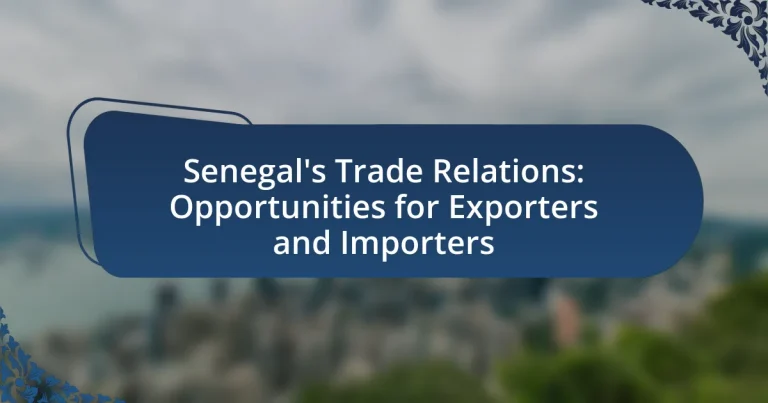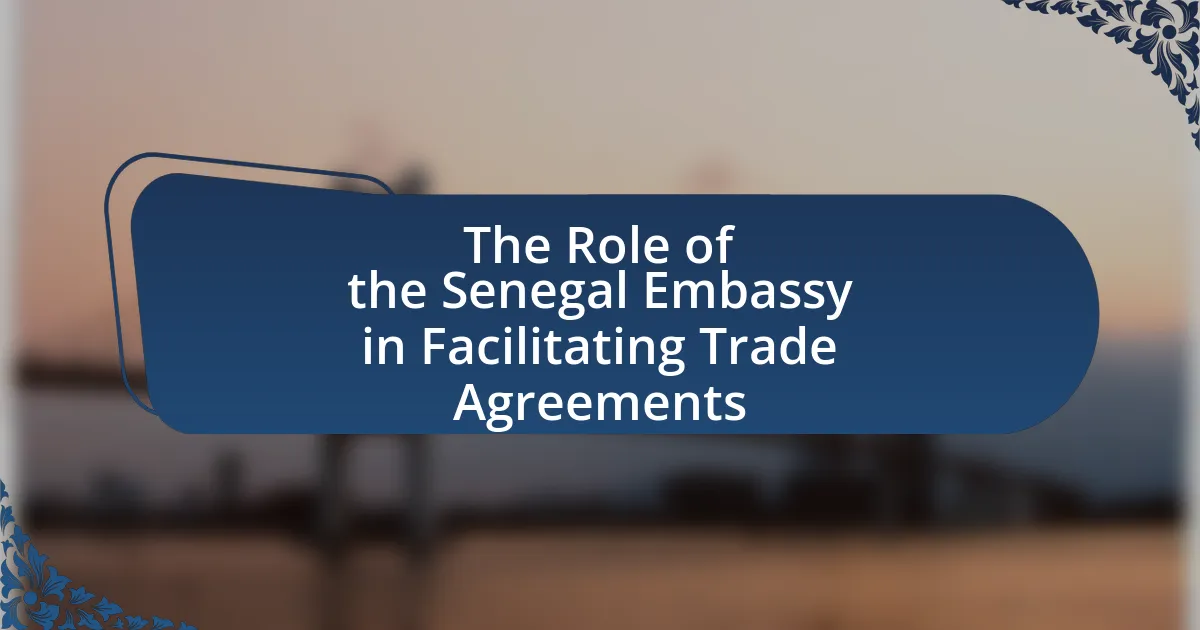Senegal’s trade relations are pivotal to its economic landscape, characterized by active participation in both regional and international markets, with a focus on exports of agricultural products, minerals, and fish. The country benefits from trade agreements with major partners such as the European Union and the United States, facilitating access to diverse markets and enhancing foreign investment. Key sectors driving trade include agriculture, mining, and fisheries, which collectively contribute significantly to Senegal’s GDP. The article explores the opportunities and challenges faced by exporters and importers in Senegal, highlighting the impact of trade agreements, current market trends, and strategies for navigating the trade environment effectively.
What are Senegal’s Trade Relations?
Senegal’s trade relations are characterized by its engagement in both regional and international markets, primarily focusing on exports of agricultural products, minerals, and fish. The country is a member of the Economic Community of West African States (ECOWAS), which facilitates trade within the region, and it has established trade agreements with various countries, including the European Union and the United States. In 2021, Senegal’s exports were valued at approximately $2.5 billion, with significant trade partners including China, France, and the United States, highlighting the diverse nature of its trade relations.
How do Senegal’s trade relations impact its economy?
Senegal’s trade relations significantly impact its economy by enhancing export opportunities and attracting foreign investment. The country has established trade agreements, such as the African Continental Free Trade Area (AfCFTA), which facilitate access to larger markets and promote economic diversification. For instance, Senegal’s exports, particularly in agricultural products and minerals, have increased due to improved trade relations, contributing to GDP growth. In 2021, Senegal’s GDP growth rate was approximately 6.1%, partly driven by a rise in exports linked to these trade agreements. Furthermore, foreign direct investment (FDI) has surged, with a reported increase of 20% in 2022, as international businesses seek to capitalize on Senegal’s strategic location and favorable trade policies.
What are the key sectors involved in Senegal’s trade?
The key sectors involved in Senegal’s trade are agriculture, mining, and fisheries. Agriculture, particularly the production of crops like peanuts and millet, constitutes a significant portion of exports, accounting for approximately 15% of the country’s GDP. The mining sector, especially phosphates and gold, plays a crucial role in trade, with mineral exports contributing to around 20% of total exports. Additionally, fisheries are vital, with Senegal being one of the largest fish producers in West Africa, contributing significantly to both domestic consumption and export revenues.
How does trade contribute to Senegal’s GDP?
Trade significantly contributes to Senegal’s GDP by accounting for approximately 60% of the country’s economic output. This contribution stems from both exports and imports, with key sectors including agriculture, fisheries, and mining driving trade activities. For instance, Senegal’s exports of goods like phosphates and agricultural products, such as peanuts and cotton, enhance foreign exchange earnings, which in turn bolster GDP. Additionally, the import of essential goods and services supports domestic consumption and production, further integrating Senegal into the global economy. The World Bank reported that in 2021, Senegal’s trade-to-GDP ratio was around 60%, highlighting the critical role of trade in economic growth and development.
What countries are Senegal’s main trading partners?
Senegal’s main trading partners are France, China, and the United States. France remains the largest trading partner due to historical ties and significant investment in Senegal’s economy, accounting for a substantial portion of Senegal’s imports and exports. China has emerged as a key partner, particularly in infrastructure development and trade, with increasing exports from Senegal to China. The United States also plays a vital role, especially in agricultural exports and investment opportunities. These relationships are supported by trade agreements and economic cooperation initiatives that enhance Senegal’s market access and economic growth.
Which regions have the strongest trade ties with Senegal?
The regions with the strongest trade ties with Senegal are the European Union, West Africa, and China. The European Union is Senegal’s largest trading partner, accounting for a significant portion of its exports and imports, particularly in agricultural products and fish. West Africa, particularly countries like Mali and Côte d’Ivoire, plays a crucial role in regional trade, with Senegal serving as a trade hub. Additionally, China has increased its trade relations with Senegal, focusing on infrastructure and investment, which has led to a growing exchange of goods and services.
How do trade agreements influence Senegal’s international relations?
Trade agreements significantly enhance Senegal’s international relations by fostering economic partnerships and increasing market access. These agreements, such as the African Continental Free Trade Area (AfCFTA) and Economic Partnership Agreements (EPAs) with the European Union, facilitate trade by reducing tariffs and non-tariff barriers, thereby encouraging foreign investment. For instance, Senegal’s participation in the AfCFTA aims to boost intra-African trade, which is projected to increase by 52% by 2022, strengthening regional ties and economic collaboration. Additionally, these trade agreements position Senegal as a strategic player in global supply chains, enhancing its diplomatic leverage and attracting international cooperation.
What are the current trends in Senegal’s trade relations?
Current trends in Senegal’s trade relations indicate a growing diversification of export markets and an increase in trade with regional partners. In recent years, Senegal has focused on strengthening ties with countries in the Economic Community of West African States (ECOWAS), enhancing intra-regional trade, which accounted for approximately 20% of its total trade in 2022. Additionally, Senegal is expanding its export base beyond traditional commodities like fish and agricultural products to include manufactured goods and services, reflecting a shift towards industrialization. The government has also implemented policies to attract foreign investment, particularly in sectors such as mining and energy, which are expected to boost trade volumes.
How has globalization affected Senegal’s trade dynamics?
Globalization has significantly enhanced Senegal’s trade dynamics by increasing access to international markets and diversifying export opportunities. The country’s integration into global supply chains has led to a rise in exports, particularly in sectors like agriculture and fisheries, which accounted for approximately 60% of Senegal’s total exports in 2021. Additionally, Senegal’s participation in regional trade agreements, such as the African Continental Free Trade Area, has further facilitated trade by reducing tariffs and improving trade relations with neighboring countries. This shift has allowed Senegal to attract foreign investment, which has bolstered its economic growth and trade capacity.
What role does technology play in enhancing trade efficiency?
Technology significantly enhances trade efficiency by streamlining processes, reducing costs, and improving communication among stakeholders. For instance, the adoption of digital platforms allows exporters and importers in Senegal to access real-time market data, facilitating informed decision-making and quicker transactions. Additionally, technologies such as blockchain improve transparency and traceability in supply chains, which can reduce fraud and errors. According to a report by the World Bank, countries that implement digital trade solutions can increase their trade volumes by up to 15%, demonstrating the tangible benefits of technology in enhancing trade efficiency.

What opportunities exist for exporters in Senegal?
Exporters in Senegal have opportunities in sectors such as agriculture, fisheries, and mining. The country is known for its production of peanuts, mangoes, and fish, which are in demand in international markets. Senegal’s strategic location along the West African coast facilitates access to regional markets, enhancing trade potential. Additionally, the government has implemented policies to promote export diversification and improve infrastructure, such as the Dakar-Diamniadio Toll Highway, which supports logistics. The African Continental Free Trade Area (AfCFTA) further opens up opportunities by reducing tariffs and increasing market access for Senegalese products across the continent.
What products are in high demand for export from Senegal?
High-demand products for export from Senegal include peanuts, fish, and cotton. Peanuts are a significant export, with Senegal being one of the largest producers in Africa, contributing to over 50% of the country’s agricultural exports. Fish, particularly octopus and shrimp, are also crucial, as Senegal’s coastline provides rich fishing grounds, making it a key player in the seafood market. Additionally, cotton exports are vital, with Senegal being a notable producer in West Africa, supplying both regional and international markets.
How can exporters identify potential markets for their goods?
Exporters can identify potential markets for their goods by conducting thorough market research, analyzing trade data, and leveraging trade agreements. Market research involves assessing consumer demand, competition, and market trends in various regions. For instance, exporters can utilize databases like the International Trade Centre’s Trade Map, which provides trade statistics and market access information. Additionally, analyzing trade data from sources such as the World Bank can reveal emerging markets with increasing demand for specific goods. Furthermore, exporters can benefit from understanding trade agreements, such as the African Continental Free Trade Area, which can facilitate access to new markets by reducing tariffs and trade barriers.
What are the challenges faced by exporters in Senegal?
Exporters in Senegal face several challenges, including inadequate infrastructure, high transportation costs, and bureaucratic hurdles. The country’s transport network, particularly roads and ports, is often underdeveloped, leading to delays and increased expenses for shipping goods. Additionally, exporters encounter complex customs procedures that can prolong the clearance process, further complicating trade. According to the World Bank, Senegal ranks 123rd out of 190 countries in the ease of doing business, highlighting the regulatory challenges that exporters must navigate. These factors collectively hinder the competitiveness of Senegalese exports in the global market.
How can exporters leverage trade agreements?
Exporters can leverage trade agreements by utilizing reduced tariffs and improved market access to enhance their competitiveness in foreign markets. For instance, Senegal’s participation in the African Continental Free Trade Area (AfCFTA) allows exporters to benefit from lower trade barriers with other African nations, facilitating easier entry into these markets. Additionally, trade agreements often include provisions for regulatory cooperation, which can streamline customs procedures and reduce compliance costs for exporters. This strategic use of trade agreements can lead to increased export volumes and expanded market reach, ultimately contributing to economic growth.
What are the benefits of regional trade agreements for Senegalese exporters?
Regional trade agreements provide significant benefits for Senegalese exporters by facilitating easier access to larger markets and reducing trade barriers. These agreements often lead to lower tariffs and improved trade conditions, enabling Senegalese products to compete more effectively in regional markets. For instance, the Economic Community of West African States (ECOWAS) promotes intra-regional trade, allowing Senegalese exporters to reach a combined market of over 300 million consumers. Additionally, regional trade agreements can enhance cooperation and collaboration among member states, leading to improved infrastructure and logistics, which further supports export activities.
How do international standards affect export opportunities?
International standards significantly enhance export opportunities by ensuring product quality and safety, which are critical for accessing global markets. Compliance with these standards, such as ISO certifications, increases buyer confidence and can lead to higher demand for products. For instance, the World Trade Organization reports that adherence to international standards can reduce trade barriers, facilitating smoother entry into foreign markets. This is particularly relevant for Senegalese exporters, as meeting these standards can differentiate their products in competitive international markets, ultimately leading to increased sales and market share.

What opportunities exist for importers in Senegal?
Importers in Senegal have opportunities primarily in sectors such as agriculture, textiles, and consumer goods. The country’s growing economy, with a GDP growth rate of approximately 6% in recent years, creates demand for imported products. Additionally, Senegal’s strategic location as a gateway to West Africa enhances access to regional markets. The government has implemented policies to facilitate trade, including reduced tariffs on certain imports and investment incentives for foreign businesses. These factors collectively provide a favorable environment for importers looking to establish or expand their operations in Senegal.
What goods are commonly imported into Senegal?
Senegal commonly imports machinery, vehicles, petroleum products, foodstuffs, and pharmaceuticals. In 2021, machinery and transport equipment accounted for approximately 30% of total imports, highlighting the country’s reliance on these goods for infrastructure and development. Additionally, petroleum products represent a significant portion of imports, as Senegal lacks sufficient domestic production to meet its energy needs. Foodstuffs, including rice and wheat, are also crucial imports due to local agricultural limitations. These import patterns reflect Senegal’s economic structure and its integration into global trade networks.
How do import tariffs impact the cost of goods in Senegal?
Import tariffs increase the cost of goods in Senegal by adding additional charges on imported products. These tariffs raise the overall price consumers pay, as businesses often pass on the increased costs to customers. For instance, Senegal’s average tariff rate was approximately 14.5% in 2021, which directly affects the pricing of imported goods, making them more expensive compared to locally produced items. This dynamic can lead to reduced consumption of imported goods and potentially stimulate local production, but it also limits consumer choices and can lead to inflationary pressures in the economy.
What are the regulatory requirements for importing into Senegal?
The regulatory requirements for importing into Senegal include obtaining an import license, ensuring compliance with customs regulations, and adhering to specific product standards. Importers must register with the Senegalese customs authority and provide necessary documentation such as a commercial invoice, packing list, and bill of lading. Additionally, certain goods may require specific permits or certifications, particularly in sectors like food and pharmaceuticals, to ensure safety and quality standards are met. Compliance with these regulations is essential for smooth customs clearance and to avoid penalties.
How can importers navigate the Senegalese market?
Importers can navigate the Senegalese market by understanding local regulations, establishing relationships with local distributors, and adapting to cultural preferences. Senegal has specific import regulations governed by the Ministry of Trade, which require compliance with customs procedures and tariffs. Building partnerships with local distributors can facilitate market entry and provide insights into consumer behavior, as local entities often have established networks and knowledge of market dynamics. Additionally, adapting products to meet local tastes and preferences is crucial, as Senegalese consumers may have distinct cultural and dietary needs. These strategies are supported by the growing trend of foreign investment in Senegal, which has seen a 20% increase in recent years, indicating a favorable environment for importers.
What strategies can importers use to establish local partnerships?
Importers can establish local partnerships in Senegal by leveraging networking opportunities, engaging in community outreach, and collaborating with local businesses. Networking at trade fairs and industry events allows importers to connect with potential partners and gain insights into the local market. Engaging in community outreach initiatives helps build trust and rapport with local stakeholders, demonstrating a commitment to the region. Collaborating with local businesses can provide importers with valuable market knowledge and distribution channels, enhancing their operational effectiveness. These strategies are supported by the growing trend of foreign investment in Senegal, which has seen a 20% increase in partnerships between local and foreign entities over the past five years, indicating a favorable environment for establishing local collaborations.
How can market research aid importers in Senegal?
Market research can significantly aid importers in Senegal by providing insights into consumer preferences, market trends, and competitive landscapes. This information enables importers to make informed decisions regarding product selection, pricing strategies, and marketing approaches. For instance, understanding local demand can help importers identify which products are likely to succeed in the Senegalese market, thereby reducing the risk of unsold inventory. Additionally, market research can reveal regulatory requirements and potential barriers to entry, allowing importers to navigate the complexities of the Senegalese trade environment more effectively.
What best practices should exporters and importers follow in Senegal?
Exporters and importers in Senegal should adhere to best practices such as understanding local regulations, establishing strong relationships with local partners, and ensuring compliance with customs procedures. Understanding local regulations is crucial as Senegal has specific import and export laws that can affect trade operations. Establishing strong relationships with local partners, including suppliers and distributors, can facilitate smoother transactions and enhance market entry. Compliance with customs procedures is essential to avoid delays and penalties; exporters and importers must be familiar with the Senegalese customs code and documentation requirements. These practices are supported by the Senegalese government’s efforts to streamline trade processes and improve the business environment, as evidenced by initiatives aimed at enhancing the ease of doing business in the country.





